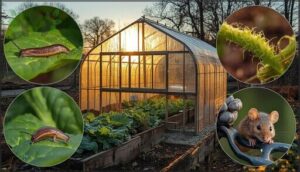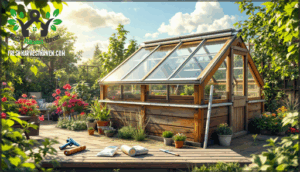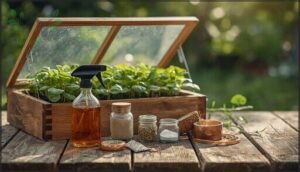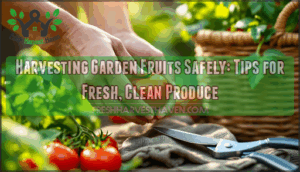This site is supported by our readers. We may earn a commission, at no cost to you, if you purchase through links.
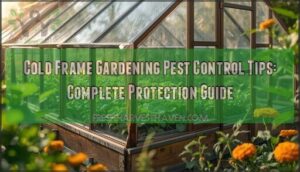
The good news? Most cold frame gardening pest control tips focus on prevention rather than damage control, which means you can stop infestations before they start. By understanding what pests hide in your frame, sealing entry points, and maintaining the right conditions, you’ll create an environment where your crops flourish and pests struggle to survive.
This guide walks you through proven strategies that actually work without relying on harsh chemicals.
Table Of Contents
Key Takeaways
- Prevention beats treatment: seal gaps, install physical barriers like mesh netting and copper strips, and maintain proper moisture/ventilation to stop pests before they establish (up to 90% effectiveness compared to damage control).
- Combine multiple defense strategies—companion planting, beneficial insects, organic sprays, and regular monitoring—to cut pest populations by 55-85% more effectively than single methods alone.
- Pests thrive in your cold frame’s warmth and moisture, so weekly scouting, daily temperature checks, and consistent cleaning (removing debris reduces pest survival by 70%) are non-negotiable habits.
- Winter protection requires structural vigilance: seal entry points under 5mm, bury frame edges 1-2 inches deep, use hardware cloth mesh, and introduce predatory beetles in fall to maintain pest control through dormancy.
Common Pests in Cold Frame Gardens
Your cold frame creates a cozy environment for plants, but pests see it the same way you do—as shelter from the elements. Slugs, aphids, and rodents are the most common troublemakers you’ll face, and catching them early makes all the difference.
Your cold frame shelters plants from winter’s bite, but it equally shelters slugs, aphids, and rodents—making early detection and prevention your strongest defense
Here’s how to identify each one before they turn your winter greens into their personal buffet.
Identifying Slugs and Snails
Slugs and snails are stealth pests that can devastate your cold frame crops overnight. You’ll spot these mollusks by their soft bodies—snails carry coiled shells while slugs don’t—and their telltale silvery slime trails across leaves and soil. Both pests thrive in moist conditions and feed nocturnally, making early morning inspections your best detection strategy. One approach is to use integrated pest management for effective control.
Key slug and snail identification markers:
- Slime trails – Silvery mucus on plant stems, cold frame walls, and soil surfaces indicates recent nocturnal activity
- Irregular leaf damage – Smooth-edged holes in lettuce, strawberries, and seedlings appear after nighttime feeding
- Size and color variation – Slugs range from 0.25 to 5 inches, displaying gray, brown, black, or orange coloration with spotted patterns
- Clear egg clusters – Round, gelatinous eggs (1/8–1/4 inch diameter) hide under planters, mulch, and boards
- Best activity conditions – Watch for damage when humidity nears 100% and temperatures stay between 38°F and 88°F
Spotting Aphid Infestations
While slugs leave slime trails, aphids work differently—they’re tiny sap-suckers you’ll find clustered on tender shoots and leaf undersides. These soft-bodied insects measure under 1/8 inch and feature two distinctive tube-like "cornicles" on their rear ends. Aphids are known to transmit various plant viruses, which can severely impact plant health.
You’ll notice sticky honeydew residue below colonies, white shed skins on stems, and curled leaves signaling active feeding. Temperature matters—aphid populations can double when your cold frame hits 72°F, so check yellow sticky traps and monitor ventilation to catch early warning signs before infestations explode. Scout weekly using a 10× hand lens, focusing on new growth where colonies establish first.
| Aphid Morphological Indicators | Environmental Infestation Signs | Scouting Monitoring Methods |
|---|---|---|
| Pear-shaped bodies under 1/8 inch with cornicles (rear tubes) | Sticky honeydew on lower leaves; black sooty mold growth | Weekly inspections with 10×–20× hand lens on leaf undersides |
| White cast skins accumulating on plant surfaces | Curled, wilted leaves and stunted new growth | Yellow sticky traps capturing winged adults during spread |
| Green, black, or yellow coloring; some species show dark stripes | Ant activity defending colonies and harvesting honeydew | Visual counts recorded in spreadsheets for population trends |
Detecting Rodent Activity (Mice and Voles)
While aphids sap your plants from above, rodents work below—and they’re far more destructive. Mice and voles burrow into your cold frame seeking warmth and food, especially as temperatures drop.
You’ll spot their presence through droppings (mice leave pointed 3–6 mm pellets; voles drop shorter, rounded ones), gnaw marks on corners and seed trays, and distinctive 1–1.5 inch tunnels near roots. Check for nests made from shredded insulation in warm corners, and watch for ammonia-like odors and greasy rub marks along their travel routes.
Daily monitoring catches early signs—disturbed soil and unearthed seeds signal trouble before populations explode. Physical barriers and sealing gaps around your frame prevent entry, keeping your overwintered crops safe.
Preventing Pest Entry and Infestations
The best defense against cold frame pests is stopping them before they get in. You can do this by sealing entry points, adding physical barriers, and choosing materials that naturally resist pest damage.
Here’s what works to keep your crops protected.
Sealing Gaps and Structural Openings
Your cold frame’s seams are your weak spot—that’s where pests slip through. Over 80% of rodent and insect infestations start at unsealed gaps around joints and foundations. Cracks larger than a quarter-inch let slugs and rodents walk right in.
Use silicone caulk or polyurethane sealant to reduce pest entry by up to 90%. For larger gaps, expanding foam works better. Add rubber weatherstripping around lids, aluminum tape at frame junctions, and door sweeps at openings.
Bury your cold frame edges 1–2 inches below soil to stop voles from tunneling underneath. Reseal every 24 months—frost cycles crack old sealant and reopen doors for pests.
Installing Physical Barriers (Netting, Copper Strips)
Physical barriers are effective because pests can’t cross what they can’t penetrate. Fine-mesh exclusion netting reduces aphid and whitefly populations by up to 75%, while properly anchored netting at cold frame edges prevents rodent and insect ingress when overlapped 10–15 cm.
For slugs and snails, copper strips placed 5–10 cm above ground deliver over 90% prevention—they trigger excessive mucus production and behavioral avoidance. Copper mesh lasts 5+ years under garden conditions.
Layer both netting installation and copper placement for thorough coverage efficiency: combined barriers cut pest activity by 85% compared to unprotected frames. Material selection matters—0.25 mm mesh stops smaller insects effectively. These physical barriers align with organic certification standards while eliminating chemical spray needs.
Choosing Pest-Resistant Cold Frame Materials
The material you choose for your cold frame determines how well pests stay out. Different materials offer varying levels of protection through their physical properties and chemical makeup.
- Polycarbonate and PVC frames achieve water repellency exceeding 95%, cutting slug presence by up to 65% compared to untreated wood, while their smooth surfaces reduce aphid egg adherence by approximately 70%.
- Cedar and redwood frames naturally resist termite and fungal degradation, extending longevity to 25 years while discouraging wood-boring insects by up to 60% more than softwoods.
- Metal mesh floors combined with solid frames eliminate over 90% of vole and mouse intrusion when properly sealed.
- Aluminum and recycled plastic lumber resist mold buildup and remain unattractive to nesting insects since they lack cellulose-based materials pests favor.
Pairing your material choice with physical barriers like insect netting and copper strips creates a complete defense system your garden can count on.
Organic and Natural Pest Control Methods
You don’t need harsh chemicals to keep your cold frame garden healthy—nature offers plenty of effective solutions. The best defense combines multiple strategies that work together: plants that repel pests, insects that hunt them, and natural substances that discourage damage.
Here’s what actually works in cold frame gardening.
Companion Planting for Pest Repellence
Think of companion planting as your cold frame’s built-in security system. When you strategically position plants together, you’re harnessing volatile organic compounds (VOCs) that disrupt how pests find their targets. Garlic, onions, and chives emit sulfur-based compounds that repel aphids and carrot flies—a chemical-free shield for your crops. Marigolds paired with brassicas cut cabbage worms by 45%, while nasturtiums act as trap crops, diverting aphids from your leafy greens by roughly 35%. The real payoff? Push-pull systems combining repellents like basil with attractants like nasturtiums reduce infestation density by up to 70%.
Maintain a 20–25 cm gap between host and companion plants for peak VOC diffusion. Seasonal rotation prevents pests from building resistance, and vertical arrangements heighten space while preserving those critical repellence distances. Enhanced microbial diversity in mixed plantings strengthens soil health, creating resilience against pathogens.
| Companion Plant | Primary Pest Target | Effectiveness |
|---|---|---|
| Garlic/Onions | Aphids, Carrot Flies | Sulfur compounds repel effectively |
| Marigolds | Cabbage Worms, Nematodes | 45% reduction in winter crops |
| Nasturtiums | Aphids, Whiteflies | 35% infestation decrease |
| Dill/Fennel | Leaf-eating Caterpillars | 40% larvae reduction via parasitic wasps |
| Basil/Thyme | Mosquitoes, Flies | Deters pests, aids pollinators |
Attracting Beneficial Insects and Predators
Your cold frame’s ecosystem thrives when you invite nature’s pest controllers to the party. Lady beetles demolish over 5,000 aphids in their lifetime, while green lacewing larvae consume 200 aphids during their 2-3 week larval stage.
Attract these allies by planting diverse flowers—they feed on nectar and pollen while patrolling for pests. Delay spring cleanup to preserve overwintering habitat for beneficial larvae and pupae.
Add mulch to boost predatory beetle populations, install shallow water trays for hydration, and avoid pesticides that eliminate your natural workforce. High plant diversity correlates directly with greater beneficial insect survival and persistence.
Using Natural Repellents and Trap Crops
Natural repellents and trap crops work as your first line of defense. Essential oils like neem and garlic extract reduce aphid populations by 68–90% when applied strategically. Nasturtiums act as a preferred trap crop, drawing aphids away from kale and lettuce—reducing infestations by up to 50% in cold-frame units.
Companion planting with marigolds suppresses nematodes by 30–40% alongside tomatoes. Combined with beneficial predators, these natural methods integrate seamlessly into your pest management system, cutting overall infestations by roughly 65% seasonally while boosting crop yields 12–18%.
Maintaining a Pest-Resistant Environment
A pest-resistant environment starts with the right conditions inside your cold frame. When you control moisture, ventilation, and cleanliness, you remove the ideal habitat where pests thrive.
Beyond the physical barriers we’ve covered, your day-to-day management practices are what keep problems from taking hold. Here’s what you need to focus on to maintain that protective edge.
Managing Moisture and Ventilation
Humidity and airflow work together as your cold frame’s climate control system. When humidity stays between 40–60%, you cut fungal disease risk by half compared to unventilated frames. Here’s why: excess moisture above 75% creates perfect breeding grounds for slugs, snails, and aphids. Proper ventilation maintains temperatures below 85°F, preventing heat stress that weakens plants. Adjustable vents reduce humidity swings by 30% on sunny days. Install openings at both top and bottom to create natural airflow—think of it as a chimney effect that pushes moist air out.
Monitor with a simple thermometer and hygrometer to keep conditions stable. When airflow stays consistent, leaf wetness drops below six hours daily, stopping fungal spores from taking hold. This integration cuts pest-induced crop losses by up to 35%.
Regular Cleaning and Debris Removal
Cleaning and debris removal form your strongest defense against pest resurgence. When you remove old plant material and fallen leaves before winter, you decrease overwintering pest survival by up to 70%—particularly slugs, snails, and rodent populations.
Here’s your cleaning action plan:
- Spring pre-sowing: Clean before sowing season; frost naturally sterilizes structures
- Mid-winter intervals: Clean every 6–8 weeks to disrupt pest life cycles
- End-of-season deep clean: Remove larvae and microbial residues after harvest
- Weekly routine: Minor cleaning during active growing maintains consistent suppression
Use mild bleach or hydrogen peroxide solution (1–2%) for material sanitation. Hot water above 60°C reduces microbial contamination by over 90%. Pressure rinse interior walls to decrease pest egg residues by 80%. Replace capillary matting annually. Compost debris away from your frame to prevent reinfestation. Clean your tools between uses—this prevents disease carryover by roughly 50% after crop rotation.
Proper tool cleaning and consistent garden sanitation dramatically boost your pest control efforts.
Monitoring Plant Health and Early Intervention
Once you’ve cleaned away debris, shift your focus to catching problems early. Scout your cold frame every 2–3 days—you’ll spot aphids, slugs, and other pests before they multiply. Yellow sticky traps capture flying insects within 48 hours, giving you a real-time count.
Install sensor systems or use thermal imaging to detect plant stress changes that signal pest pressure. Data analysis from temperature and humidity logs reveals when conditions favor pest reproduction. Remote monitoring alerts you to humidity spikes or temperature swings that stress your plants, making them vulnerable.
Act within 72 hours of detecting pests—manual removal and natural predators work 40% better when you respond fast.
Seasonal Pest Control Strategies
Pests don’t take a break—they adapt with the seasons, and so should your defense strategy. What works to stop aphids in spring mightn’t protect your winter greens, and the moisture that feeds slugs in fall creates different challenges when temperatures drop.
Learning how to adjust your pest control approach throughout the year keeps your cold frame crops healthy no matter what the calendar throws at you.
Spring and Summer Pest Prevention Tips
As temperatures climb in spring and summer, warm-season pests become aggressive in your cold frame. Early detection is your first line of defense—inspect under leaves weekly to catch aphids, slugs, and beetles before damage spreads.
Preventative measures like summer ventilation are critical; automatic vent openers maintain 18–24°C daytime temperatures, reducing aphid reproduction by over 60%. Install insect netting with 0.6 mm mesh to exclude pests with 95% effectiveness.
Natural defenses work best now: introduce lady beetles or lacewing larvae to control aphid populations dramatically. Companion flowers like dill attract predatory wasps. These organic pest control strategies protect your crops without chemicals while keeping your cold frame thriving.
Fall and Winter Pest Management Adjustments
As temperatures drop, pest dormancy shifts your strategy. Most insects enter diapause by December, but aphids remain semi-active above −5°C in your protected frame. That’s why fall and winter pest prevention demands structural vigilance and biological integrations.
Seal every gap under 5 mm—rodents compress through surprisingly small openings. Weekly monitoring practices catch slug trails and early aphid activity before plant damage shows. Maintain moisture control by ventilating every 2–3 days to keep humidity between 55–65%, which deters breeding grounds.
Apply copper strips along entry points for slug defense, and introduce predatory beetles in autumn to cut aphid populations by 70%. These dormancy effects combined with structural integrity keep your cold frame pest-free through the coldest months.
Protecting Overwintering Crops From Pests
As winter sets in, your overwintering crops face concentrated pest pressure in the protected cold frame environment. Temperatures inside remain 3–8°C warmer than outside, creating ideal conditions for aphids to reproduce through multiple generations and slugs to stay active at soil temperatures as low as 5°C.
Protect your crops by applying diatomaceous earth at frame edges in late autumn to reduce crawling pest intrusion by 55%. Introduce ladybird beetles and lacewings in fall—they’ll cut aphid populations by up to 95% in confined spaces. Maintain soil moisture between 20–25% to reduce slug egg viability by 70%, and rotate crops yearly between leafy greens and root vegetables to break pest habitat continuity.
Set traps in February–March for early detection, catching infestations before they establish. Bury frame edges 10–15 cm into soil and use hardware cloth with mesh openings ≤6 mm to exclude rodents entirely. These structural protections paired with beneficial insects create a resilient defense system that keeps your winter harvest thriving.
DIY and Product-Based Pest Solutions
You’ve already tackled the big pest problems—now it’s time to arm yourself with the right tools. Whether you prefer mixing up homemade solutions or reaching for tested products, you have plenty of options that work without harsh chemicals.
Here’s what actually works for cold frames.
Homemade Pest Deterrents and Traps
Your DIY pest control arsenal doesn’t require expensive products—just science-backed solutions you can make at home. Mix DIY soap sprays (1–2 teaspoons mild soap per gallon water) to reduce aphids by up to 85% with repeated applications. Essential oil repellents like thyme and spearmint are lethal to slugs at low concentrations, while botanical extract infusions of garlic and chili cut mealybug populations roughly in half. Mechanical pest traps—yellow sticky cards and copper tape barriers—catch invaders before infestations spread, with traps achieving 90% detection accuracy near cold frame bases. Integrated deterrent strategies combining soap, oils, and traps expand coverage by 60% compared to single methods and delay reinfestation up to three weeks.
- DIY Soap Sprays: Affordable, reduce soft-bodied pest populations dramatically, reapply every 4–7 days during active infestations.
- Essential Oil and Botanical Infusions: Utilize natural molluscicidal and repellent power; garlic and thyme work fastest against slugs and mealybugs.
- Mechanical Traps with Strategic Placement: Deploy yellow sticky traps and copper barriers weekly; they’re your early warning system before damage accelerates.
Recommended Cold Frame Accessories and Tools
Your cold frame’s defense system starts with the right gear. Install automatic vent openers (operating between 12–26°C) to regulate temperature and prevent pest-favorable conditions, paired with a digital thermometer for ±1°C accuracy monitoring. Physical barriers like fine-mesh insect netting (0.8 mm aperture) block aphids and thrips, while copper tape achieves 85–95% slug deterrence. Yellow sticky traps capture flying insects with 90% efficacy—your early warning system. Weatherproof sealing tapes reduce air leakage by 20%, blocking pest entry points. Deploy these tools strategically: they’re your foundation for staying ahead of infestations.
| Tool | Pest Prevention Benefit |
|---|---|
| Automatic vent opener + digital thermometer | Maintains ideal temps; prevents pest-thriving conditions |
| Insect netting & row covers | Blocks aphids, thrips, whiteflies before entry |
| Copper tape barriers | 85–95% slug/snail deterrence around frame base |
| Yellow sticky traps | 90% efficacy for flying pest detection |
| Weather-resistant sealing tape | Reduces air leakage 20%; closes rodent entry gaps |
| Soil thermometer | Monitors moisture zones; prevents slug breeding (below 60%) |
Safe Use of Organic Sprays and Barriers
When you spray organic pest control, timing matters—evening applications reduce breakdown by 25% compared to daytime spraying. Neem oil and spinosad work best at 7–10 day intervals, and mixing them with Bt enhances coverage by 40%. Wear gloves and long sleeves to cut exposure by 90%.
Physical barriers like copper strips achieve 85–95% slug deterrence, while fine-mesh netting blocks 95% of aphids without restricting airflow. Combining spray applications with row covers cuts aphid density by 55–70%—that’s your integrated pest management advantage.
Rotate between biopesticide classes to prevent resistance buildup across growing cycles.
Frequently Asked Questions (FAQs)
How often should I check cold frame temperature during winter?
Keeping your finger on the pulse matters here. Check temperatures daily during winter—morning and evening work best. This twice-daily frost risk assessment catches dangerous swings before they harm your crops.
Winter crop sensitivity peaks in cold snaps, so remote monitoring tools with alerts give you peace of mind and prevent overheating or freeze damage.
Can I use pesticides inside my cold frame safely?
Pesticides in cold frames pose serious risks you shouldn’t ignore. Enclosed spaces concentrate toxic fumes, increasing inhalation and skin exposure dangers. Most synthetic pesticides—like organophosphates and pyrethroids—are unsuitable due to volatility and persistence. Organic options such as insecticidal soaps are safer.
Your best approach? Use integrated pest management: seal gaps, install barriers, manage moisture, and monitor plants. Reserve pesticides only as a last resort, following label instructions carefully.
Whats the best way to winterize a cold frame?
Winterize your cold frame by sealing gaps to reduce heat loss by 15-20%. Add insulation—straw bales, soil banks, or bubble wrap—to maintain temperatures 5-10°F warmer.
Secure proper drainage and ventilation to control moisture and prevent fungal disease while protecting overwintering plants from freezing damage.
Should I water plants differently in cold frames?
Yes, water your cold frame plants differently. The controlled humidity and reduced evaporation mean you’ll water far less—usually once weekly in winter versus outdoor gardens.
High humidity decreases transpiration by 5 to 2 times, so soil moisture retention improves dramatically. Water at soil level early in the day to keep foliage dry and prevent fungal disease.
Check soil moisture regularly and adjust based on plant type and ventilation conditions.
How do I know when to open or close the cold frame lid?
Monitor your external temperature daily. When it exceeds 85°F, crack the lid open to prevent overheating. Below 45°F, keep it closed for heat retention.
Use a thermometer to track internal conditions and adjust ventilation accordingly—opening on warm sunny days, closing at night for air circulation and temperature control.
Conclusion
Your cold frame is like a fortress—but one with an open gate if you’re not vigilant. The strategies in this guide transform that vulnerability into your advantage. By sealing entry points, maintaining proper moisture and airflow, and catching problems early, you’ve created an environment where pests can’t establish a foothold.
Cold frame gardening pest control tips work best when prevention becomes habit, not afterthought. Your plants will thrive when pests simply can’t survive.

